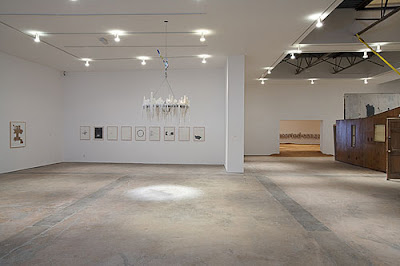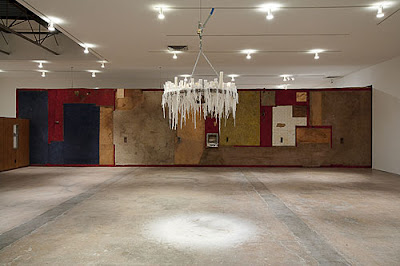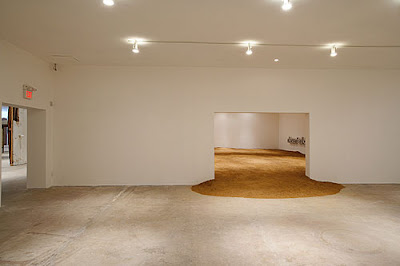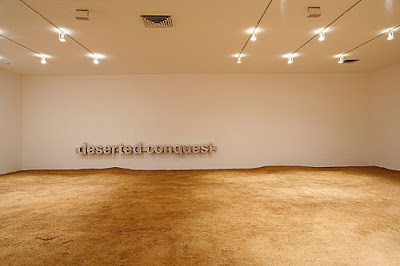
SITE Santa Fe, the contemporary art space on Santa Fe's Railyard District, commissioned an Austrian artist named Hans Schabus to take over their entire building with his meditations on the desert. From the essay accompanying the exhibition:
In Deserted Conquest (2007) -- an installation commissioned by SITE Santa Fe and the artist's first solo museum exhibition in the United States -- Schabus stages a series of confrontations (permanence vs. mobility; the grid vs. spiral form; artificial vs. natural; among others) within the New Mexico landscape that questions our beliefs about the desert and the American West. The objects in this exhibition -- a deconstructed mobile home, two videos, collages, over 100 tons of dirt, and an assortment of "found" items -- not only embody the oppositions that Schabus sets up, but also speak abstractly to notions of history, mythology, and alienation.
-- From the Exhibition Essay, which fails to mention an author's name.

As a whole, I enjoyed the space very much. Schabus makes huge installations out of mobile homes and the walls of old buildings, using their weathered and dilapidated aesthetics in contrast to the whiteness of the gallery space. He accents this with Cabin Fever, an interesting wagon wheel chandelier holding some two dozen candles, continuously lit and allowed to drip onto the floor over time.

In addition to these installations, Schabus takes some video footage from Yeso, NM, juxtaposing the loud, oncoming train with the dead quiet of the now ghost town. It was a stunning video that really resonated the emptiness of Yeso's spaces and the power and beauty of an oncoming train. The piece is called East, West, South, North
The title installation, Deserted Conquest is something like 10 tons of dirt packed down into a room that has its title emblazoned on the wall in steel. I imagine the space changes over time as visitors explore the empty room that is literally just full of desert dirt.



But what was most interesting, however unintended, was the fact that I was almost alone in this room. That is to say, I was actually the only patron in the entire gallery when I viewed it, but I was not the only human being. As I walked into the building, I was greeted at the desk and immediately headed into the exhibition (it was Friday, which means that there is no admission fee). I was tailed by a young woman, probably in her early twenties, who was carrying a walkie-talkie and was dressed in the casual, dark toned uniform of a SITE employee. She told me to watch my head on a specific, slightly hidden piece. This was our last direct interaction; after that, she casually milled about in whatever vicinity I was in the museum.
Now, I understand this is her job, but I felt sorry for her because she was obviously uncomfortable walking around with me but without interacting with me, basically "keeping watch" over something that hardly needed watching-over. I ended up feeling strange because I was wandering in Schabus' purposeful emptiness, an expanse that, like our romantic notions of the desert journey, seems best suited for solo exploration. Happening upon the space at the right moment allowed me such a solitary experience that was constantly disrupted by the woman guarding me throughout my viewing of Schabus' work.
Ultimately, I came to associate her presence with that of a ghost. She would not follow directly behind me, but rather wander between the rooms quickly enough to not seem like I was under constant surveillance. I instead felt like I was always vaguely being followed by something that, upon turning around, was just disappearing behind a corner.
In the end, this added to the experience Schabus sets up in his recreation of the solitude and expanse of the desert, as the ghost town of Yeso came to embody the dirt covered floor, leaving only a wispy trace of life that is always just behind you but outside of reach, outside of language, and experiencing something wholly different than you are.

